Spaghetti Carbonara is one of those dishes that looks fancy but is actually super simple. It’s basically pasta, guanciale (or pancetta/bacon), eggs, cheese, and a little black pepper. That’s it—no heavy cream needed. In under 20 minutes, you’ll have a cozy, comforting meal. Ready to dive in? Let’s make some carbonara.
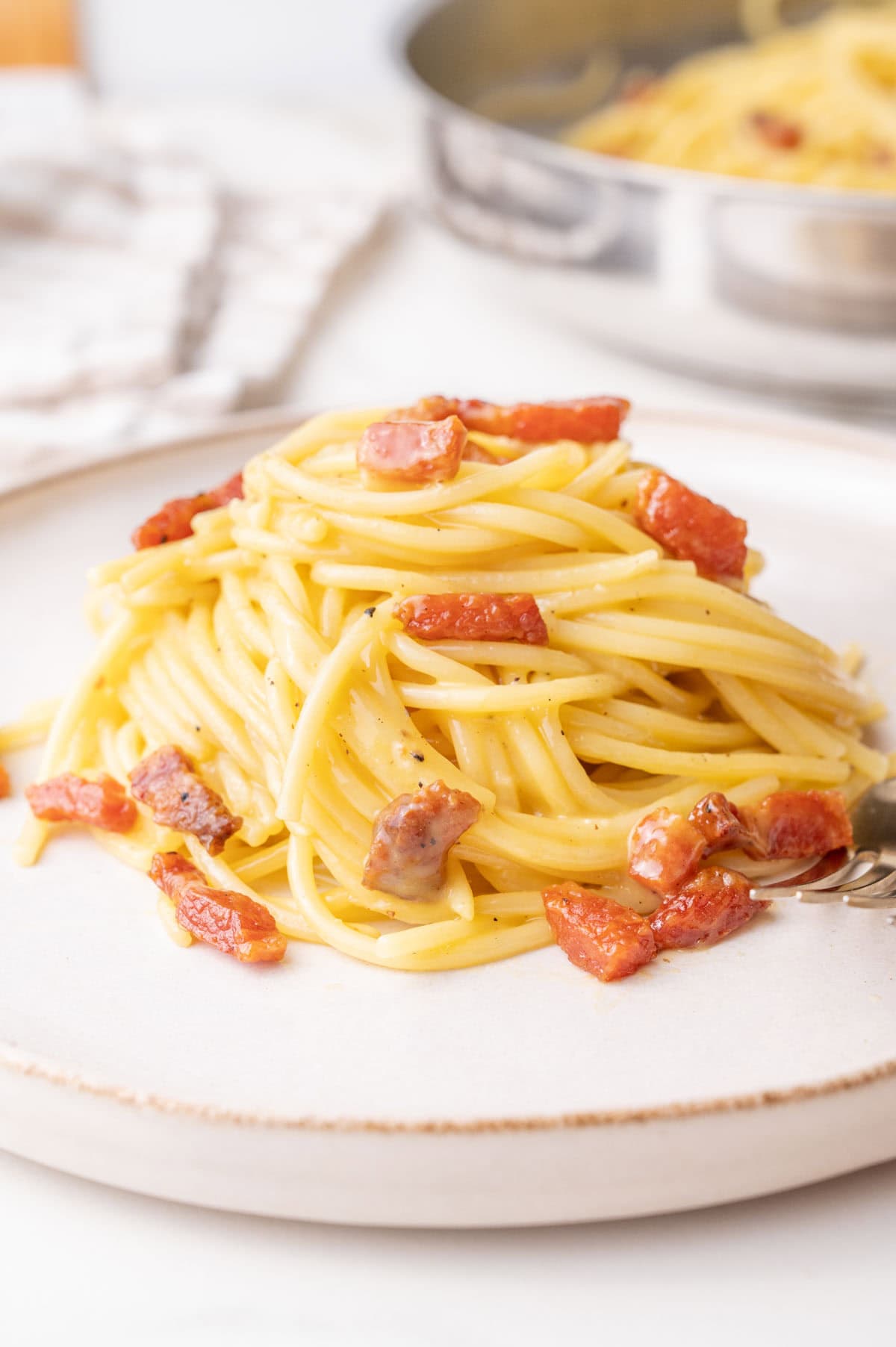
Ingredients
Here’s what you need to make this easy recipe:
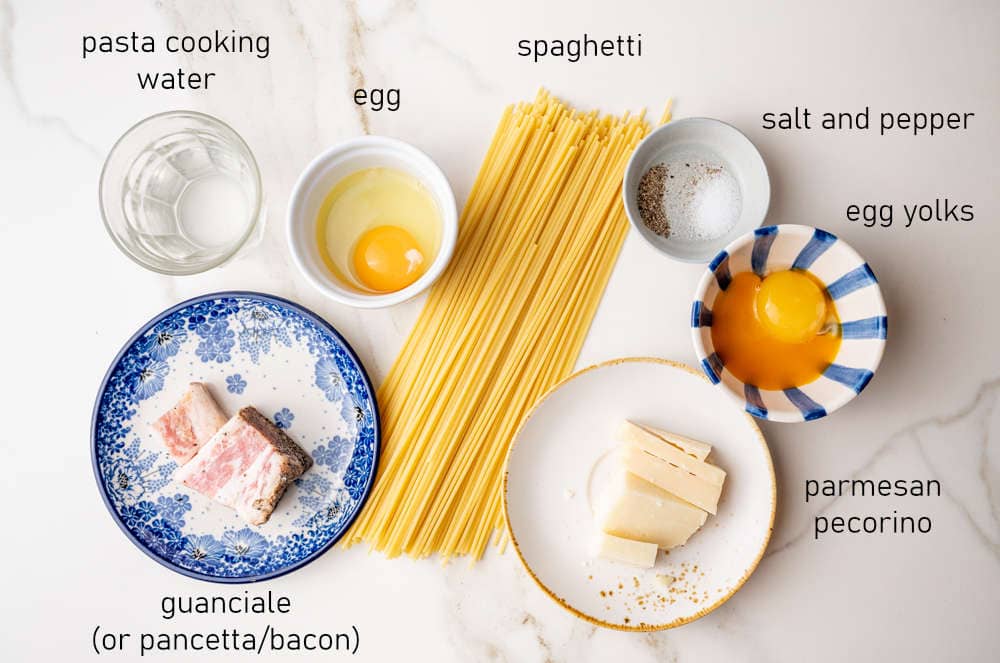
- Pasta – In my opinion, the best pasta for this recipe is spaghetti, but you can also use linguine.
- Cheese – You can use just Parmesan cheese or just Pecorino cheese in this recipe. Traditionally, it’s made with just Pecorino cheese. I chose to use both because I prefer the milder, creamier flavor of Parmesan. While Parmesan and Pecorino are similar types of hard cheese, Parmesan is made from cow’s milk, while Pecorino is made from sheep’s milk, giving it a tangier flavor. Try both and decide which you like best! Don’t use pre-shredded cheese, it will not melt as easily as freshly grated cheese!
- Guanciale – is the traditional meat used in carbonara. It’s an Italian cured pork jowl (cheek), known for its rich, slightly sweet flavor, and melt-in-your-mouth texture. If you can’t find guanciale, pancetta is the next best option—it’s also cured pork but comes from the belly, giving it a slightly less fatty and milder taste. Bacon can work in a pinch, but keep in mind it’s smoked, so it will add a different, less traditional flavor to the dish. For the best results, try to stick with guanciale or pancetta for that authentic carbonara experience!
- Eggs – Using one whole egg plus two egg yolks makes the sauce extra rich and creamy without needing any heavy cream. The whole egg adds a little more volume and helps bind everything together, while the extra yolks thicken the sauce and make it rich, creamy, and flavorful. You can use just 1 egg yolk or 2 if you want a richer sauce.
- Black pepper – freshly ground black pepper adds a warm slightly spicy kick that balances the richness of the sauce and complements the salty, savory meat. Don’t be shy with it!
- Pasta cooking water – Pasta cooking water is another secret to perfect carbonara. The starchy water helps thicken the sauce and creates a silky texture, while also diluting it just enough to coat every strand of pasta evenly. Don’t forget to save some before draining the pasta!
How to make it step-by-step
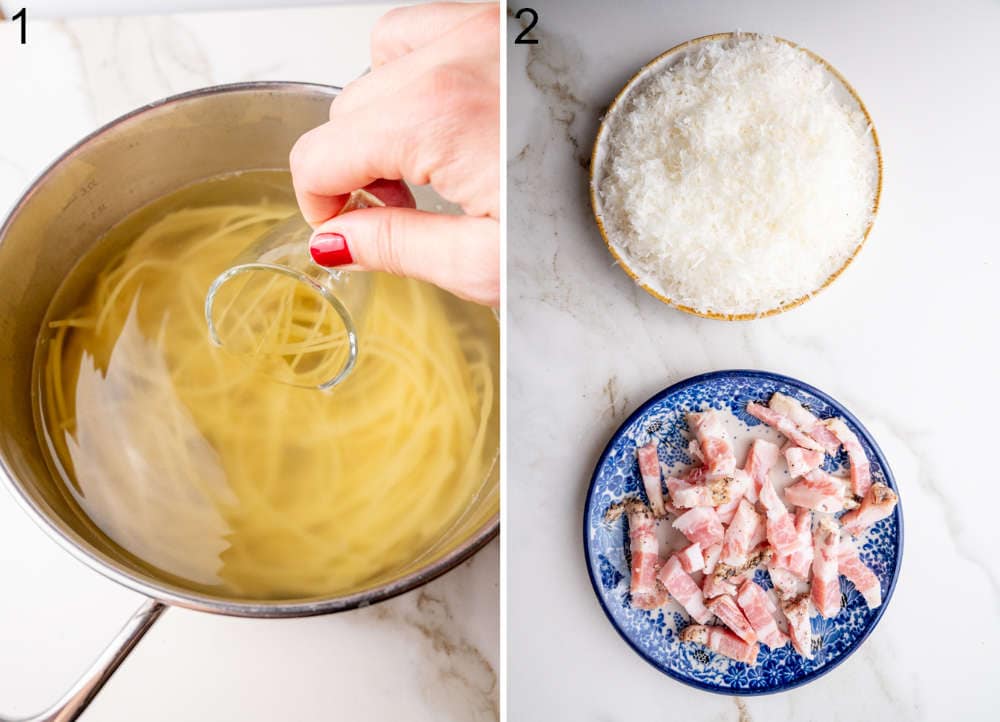
STEP 1: Cook the pasta:
Bring well-salted water to a boil, add the pasta, and cook according to the package instructions until al dente. At the end of the cooking time, reserve about 1/2 cup of the pasta cooking water. Make sure not to overcook the pasta—it should still have a bite to it. The amount of water should be moderate, just enough for the pasta to freely swim in it. The less water you use, the more concentrated the starch in the water will be, which helps thicken your sauce.
(1/2 pound (225g) dried spaghetti)
STEP 2: Prepare the ingredients:
Cut the meat into small cubes or batons (thin strips about 1-inch (2cm) long). Finely grate both types of cheese using the small holes of a grater or, preferably, a Microplane grater (very finely shredded cheese melts more easily).
(4 ounces (115g) guanciale, or pancetta/bacon, 1 ounce (30g) pecorino cheese, 1 ounce (30g) parmesan)
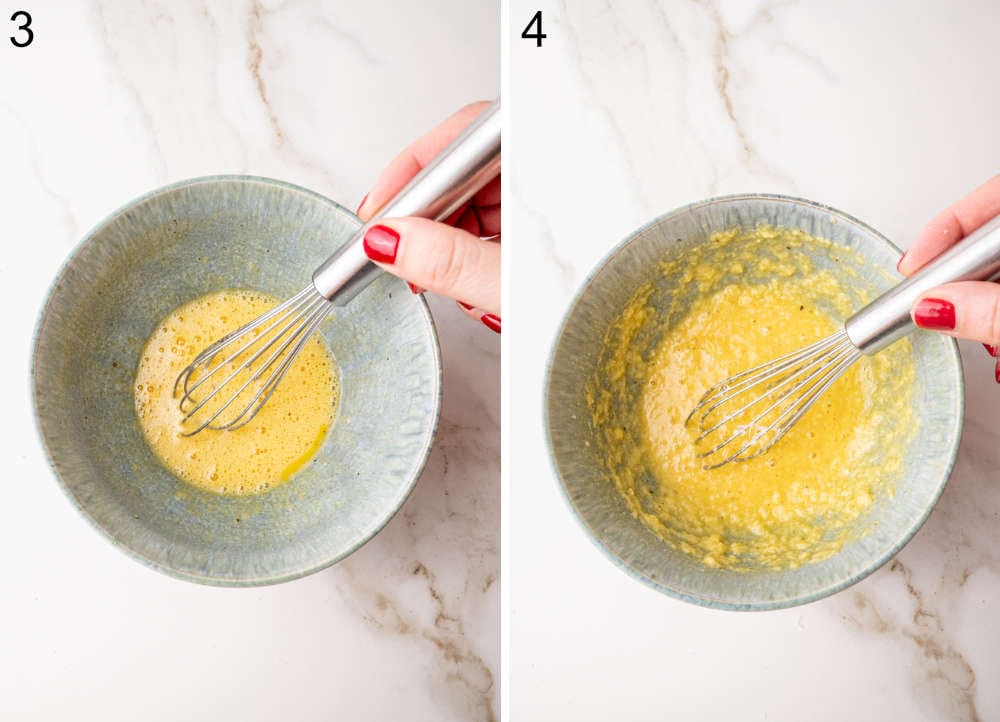
STEP 3+4: Make the pasta sauce: While the pasta and guanciale are cooking, prepare the sauce. In a medium bowl, whisk together the egg and egg yolks until well combined.
Add the grated cheese and freshly ground black pepper, and whisk again until the mixture is smooth and well combined.
(1 egg, 2 egg yolks, using just 1 egg yolk is also fine, 1/4 teaspoon freshly ground black pepper, or more, to taste)
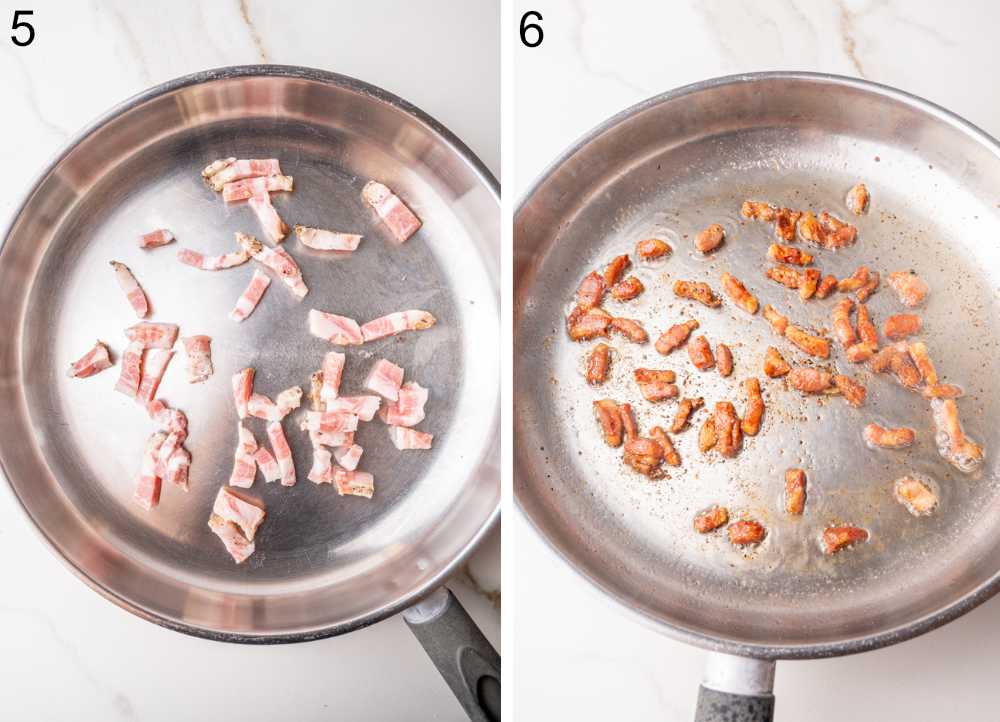
Would you like to save this?
STEP 5+6: Cook the guanciale:
Add the guanciale to a cold frying pan and set it over medium heat. Cook for a few minutes until the fat renders (melts out of the meat), and the guanciale becomes browned and crispy. Transfer the guanciale to a plate, leaving the rendered fat in the pan. If your guanciale is very fatty, you can remove some of the excess fat, but be sure to leave enough to flavor the dish. Take the pan off the heat.
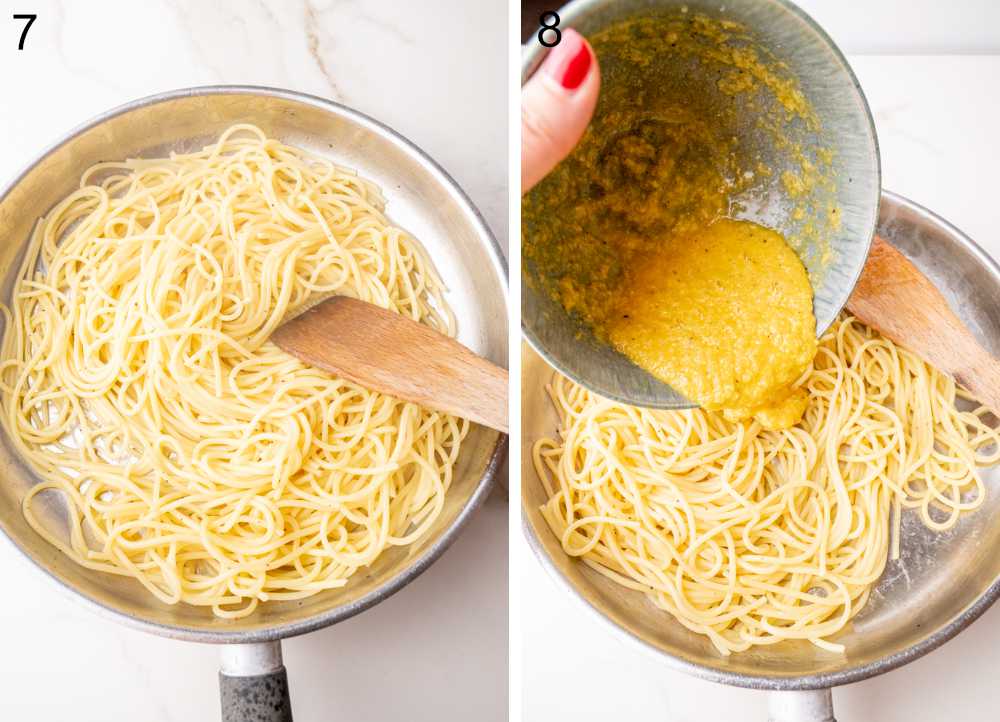
STEP 7: Drain the pasta and return it to the pan. Toss it with the reserved guanciale fat. If you’ve just finished cooking the guanciale, take the pan off the heat and let it cool for 1-2 minutes. The pasta and pan should no longer be sizzling, as excessive heat can cause the eggs in the sauce to scramble.
STEP 8: Add the cheese-egg mixture and 3 tablespoons of the reserved pasta cooking water.
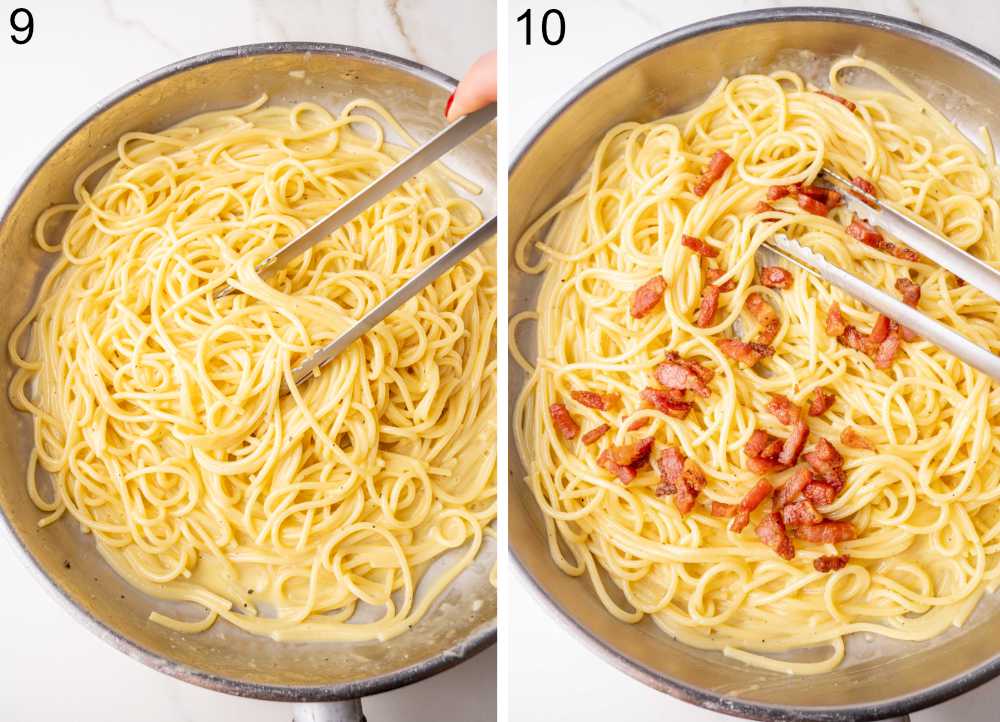
STEP 9: Toss vigorously until the cheese melts and the mixture transforms into a creamy sauce. If the sauce is too thick, add more pasta cooking water, one tablespoon at a time, until the desired consistency is achieved. If the pasta is too cool and the sauce isn’t melting, you can return the pan to the heat on the lowest setting. Warm it very gently, stirring constantly, just until the sauce becomes creamy and smooth. Remove the pan from the heat immediately, as the sauce can scramble quickly if overheated, and this cannot be undone.
STEP 10: Season the pasta with salt, if necessary (both types of cheese are already salty, so taste first), and generously sprinkle with lots of freshly ground black pepper. Top with the crispy guanciale and serve.
Enjoy!
Storage
Carbonara is best prepared fresh, as the creamy sauce doesn’t store well, and the pasta tends to become mushy and absorb the sauce. If you have leftovers, store them in an airtight container in the refrigerator for up to 3 days. Reheat gently in a pan over low heat or in short microwave intervals, adding a splash of water or cream to loosen the sauce. Freezing is not recommended, as the sauce may separate. Consume promptly and check for freshness before eating.
Top tips for perfect Pasta Carbonara
- The golden rule of carbonara: Always mix the hot pasta with the egg and cheese mixture off the heat. This keeps the eggs from scrambling and helps create a smooth, creamy sauce.
- No need for cream! The creaminess of carbonara comes from the emulsion of eggs, cheese, pasta water, and rendered fat from guanciale—no heavy cream required.
- Mix eggs and cheese first: Beat the eggs with grated cheese in a bowl before adding them to the pasta. This ensures even distribution and prevents the eggs from cooking unevenly and getting scrambled.
- Raw eggs? Not quite! The eggs are gently cooked by the residual heat of the pasta, thickening into a silky sauce without scrambling.
- Pecorino & Parmesan for balance: A mix of Pecorino Romano and Parmesan gives the best flavor—Pecorino adds sharpness, while Parmesan mellows it out with a nutty taste.
- Guanciale is king: The rich, cured pork jowl adds the most authentic flavor. Plus, the rendered fat emulsifies into the sauce, making it extra luscious.
- Start guanciale in a cold pan: This helps the fat render slowly, crisping the meat perfectly without needing extra oil.
- Perfect pasta texture: Always cook your pasta al dente in well-salted water. This way, it holds its texture and absorbs the sauce beautifully.
More quick and easy pasta recipes you may enjoy
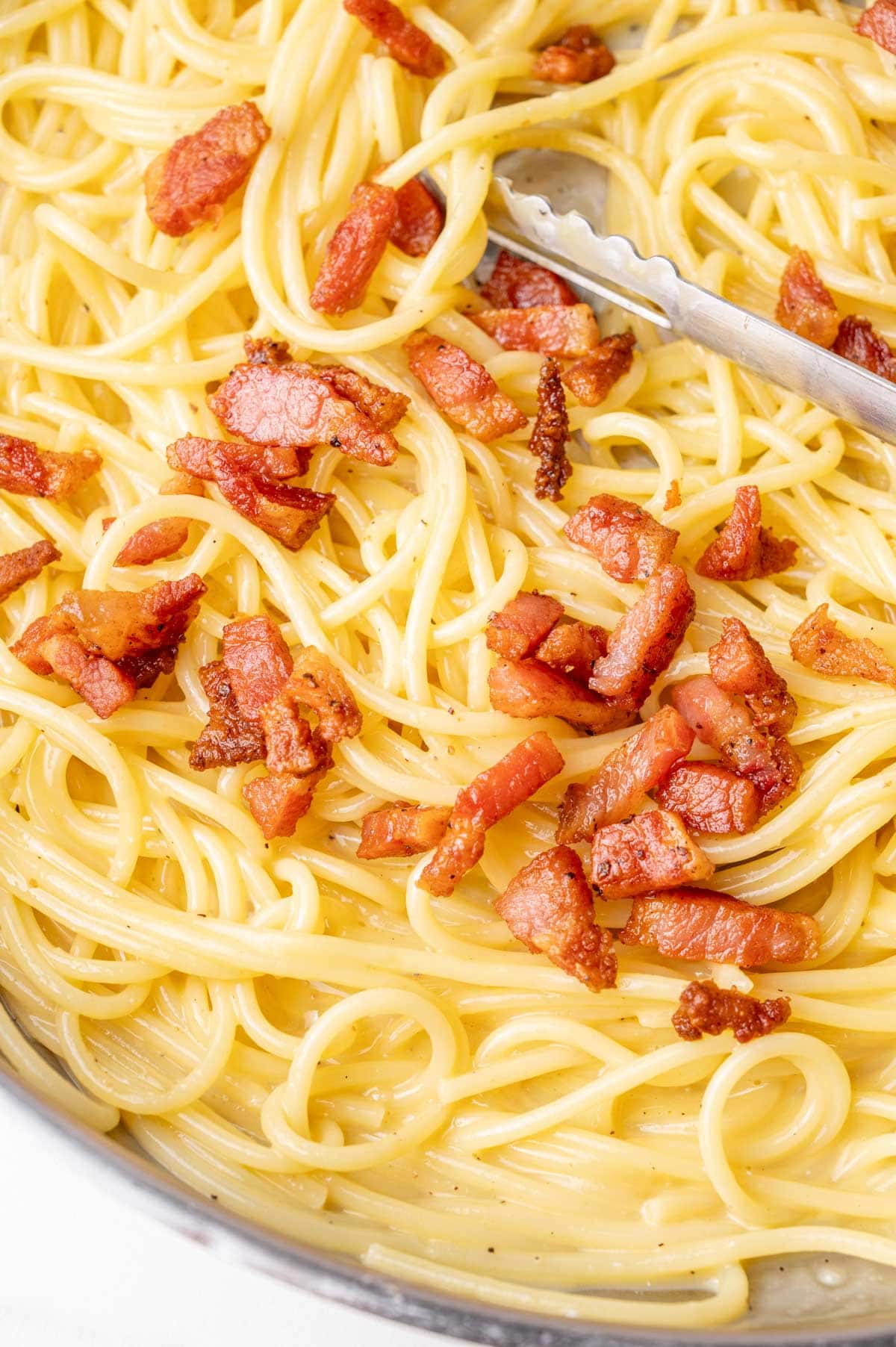
Did you make this recipe? RATE THE RECIPE or tell me in the COMMENTS how you liked it! You can also add a photo of your dish. It would make me very happy and will help other readers. Thank you!!
Spaghetti Carbonara
Ingredients
- 1/2 pound (225g) dried spaghetti
- 4 ounces (115g) guanciale or pancetta/bacon
- 1 egg
- 2 egg yolks using just 1 egg yolk is also fine
- 1 ounce (30g) pecorino cheese
- 1 ounce (30g) parmesan*
- 1/4 teaspoon freshly ground black pepper or more, to taste
- 3-4 tablespoons pasta cooking water more if needed
- salt to taste
Would you like to save this?
Instructions
- Cook the pasta: Bring well-salted water to a boil, add the pasta, and cook according to the package instructions until al dente. At the end of the cooking time, reserve about 1/2 cup of the pasta cooking water. Make sure not to overcook the pasta—it should still have a bite to it. The amount of water should be moderate, just enough for the pasta to freely swim in it. The less water you use, the more concentrated the starch in the water will be, which helps thicken your sauce.1/2 pound (225g) dried spaghetti
- Cook the guanciale: Cut the meat into small cubes or batons (thin strips about 1-inch (2cm) long). Add the guanciale to a cold frying pan and set it over medium heat. Cook for a few minutes until the fat renders (melts out of the meat), and the guanciale becomes browned and crispy. Transfer the guanciale to a plate, leaving the rendered fat in the pan. If your guanciale is very fatty, you can remove some of the excess fat, but be sure to leave enough to flavor the dish. Take the pan off the heat.4 ounces (115g) guanciale
- Make the pasta sauce: While the pasta and guanciale are cooking, prepare the sauce. Finely grate both types of cheese using the small holes of a grater or, preferably, a Microplane grater (very finely shredded cheese melts more easily). In a medium bowl, whisk together the egg and egg yolks until well combined. Add the grated cheese and freshly ground black pepper, and whisk again until the mixture is smooth and well combined.1 egg, 2 egg yolks, 1 ounce (30g) pecorino cheese, 1 ounce (30g) parmesan*, 1/4 teaspoon freshly ground black pepper
- Assemble: Drain the pasta and return it to the pan. Toss it with the reserved guanciale fat. If you’ve just finished cooking the guanciale, take the pan off the heat and let it cool for 1-2 minutes. The pasta and pan should no longer be sizzling, as excessive heat can cause the eggs in the sauce to scramble.
- Add the cheese-egg mixture and 3 tablespoons of the reserved pasta cooking water. Toss vigorously until the cheese melts and the mixture transforms into a creamy sauce. If the sauce is too thick, add more pasta cooking water, one tablespoon at a time, until the desired consistency is achieved. If the pasta is too cool and the sauce isn’t melting, you can return the pan to the heat on the lowest setting. Warm it very gently, stirring constantly, just until the sauce becomes creamy and smooth. Remove the pan from the heat immediately, as the sauce can scramble quickly if overheated, and this cannot be undone.3-4 tablespoons pasta cooking water
- Season the pasta with salt, if necessary (both types of cheese are already salty, so taste first), and generously sprinkle with lots of freshly ground black pepper. Top with the crispy guanciale and serve.
- Enjoy!
Notes
- You can use either just Parmesan cheese or just Pecorino cheese in this recipe. Traditionally, it’s made with just Pecorino cheese. I chose to use both because I prefer the milder, creamier flavor of Parmesan. While Parmesan and Pecorino are similar types of hard cheese, Parmesan is made from cow’s milk, while Pecorino is made from sheep’s milk, giving it a tangier and sharper flavor. Try both and decide which you like best!
- Don’t use pre-shredded cheese, it will not melt as easily as freshly grated cheese!
- If using just 1 egg yolk, add just 1-2 tablespoons of water and then asses if you need more. The sauce will be thinner with less yolks.
- Calories = 1 serving (1/2 of the recipe). This is only an estimate!

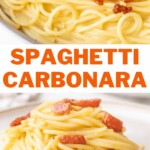
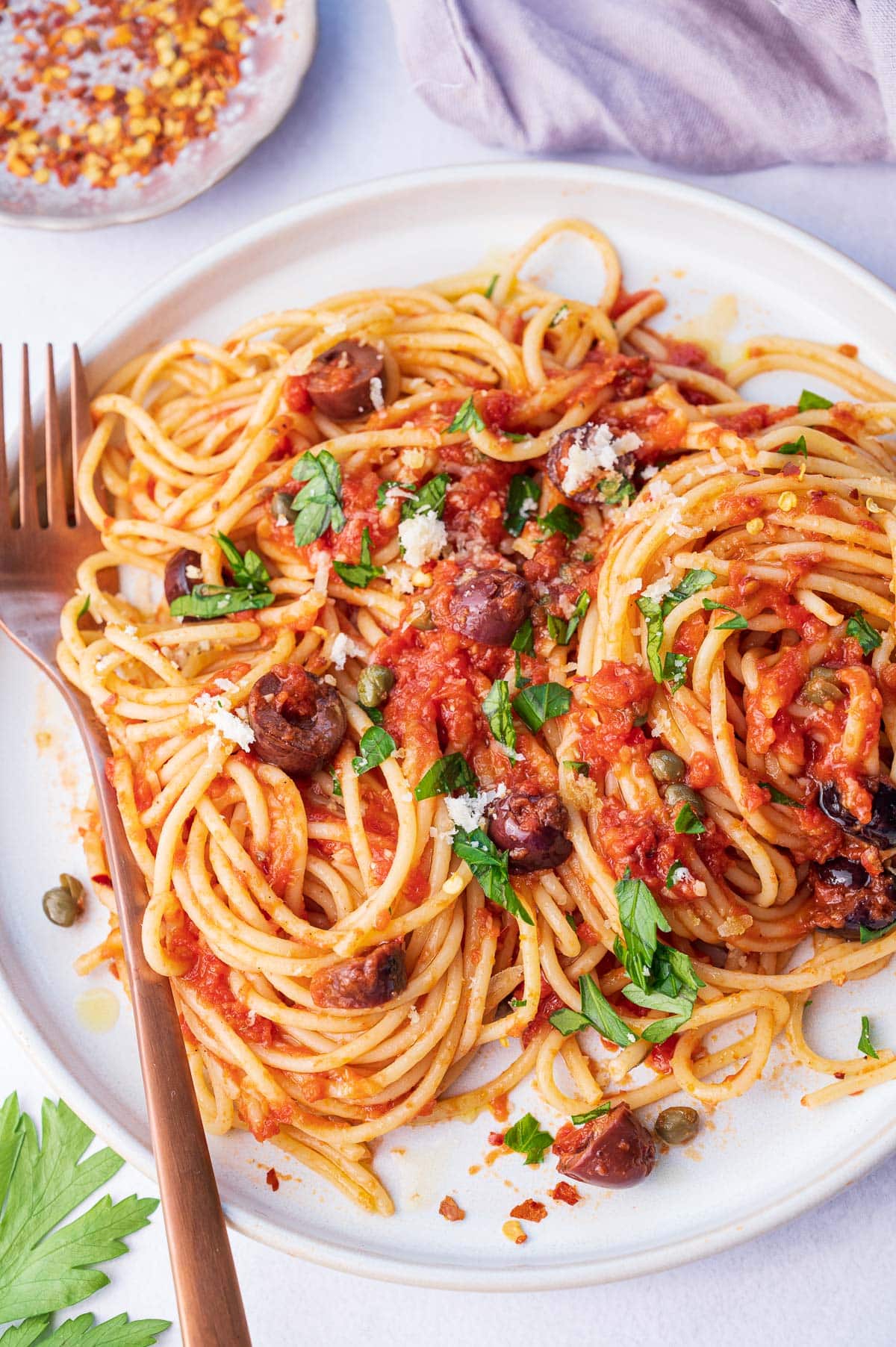
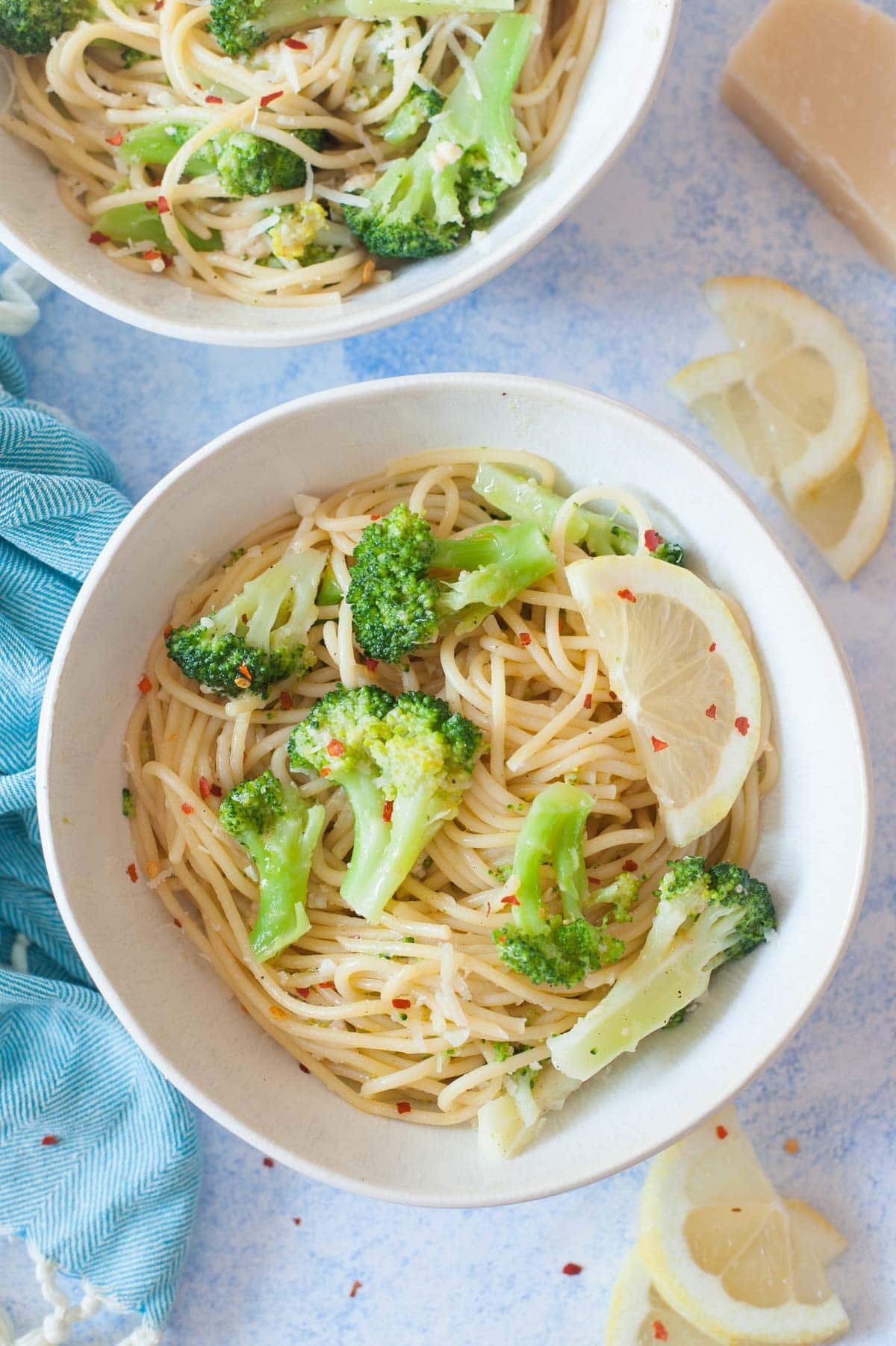
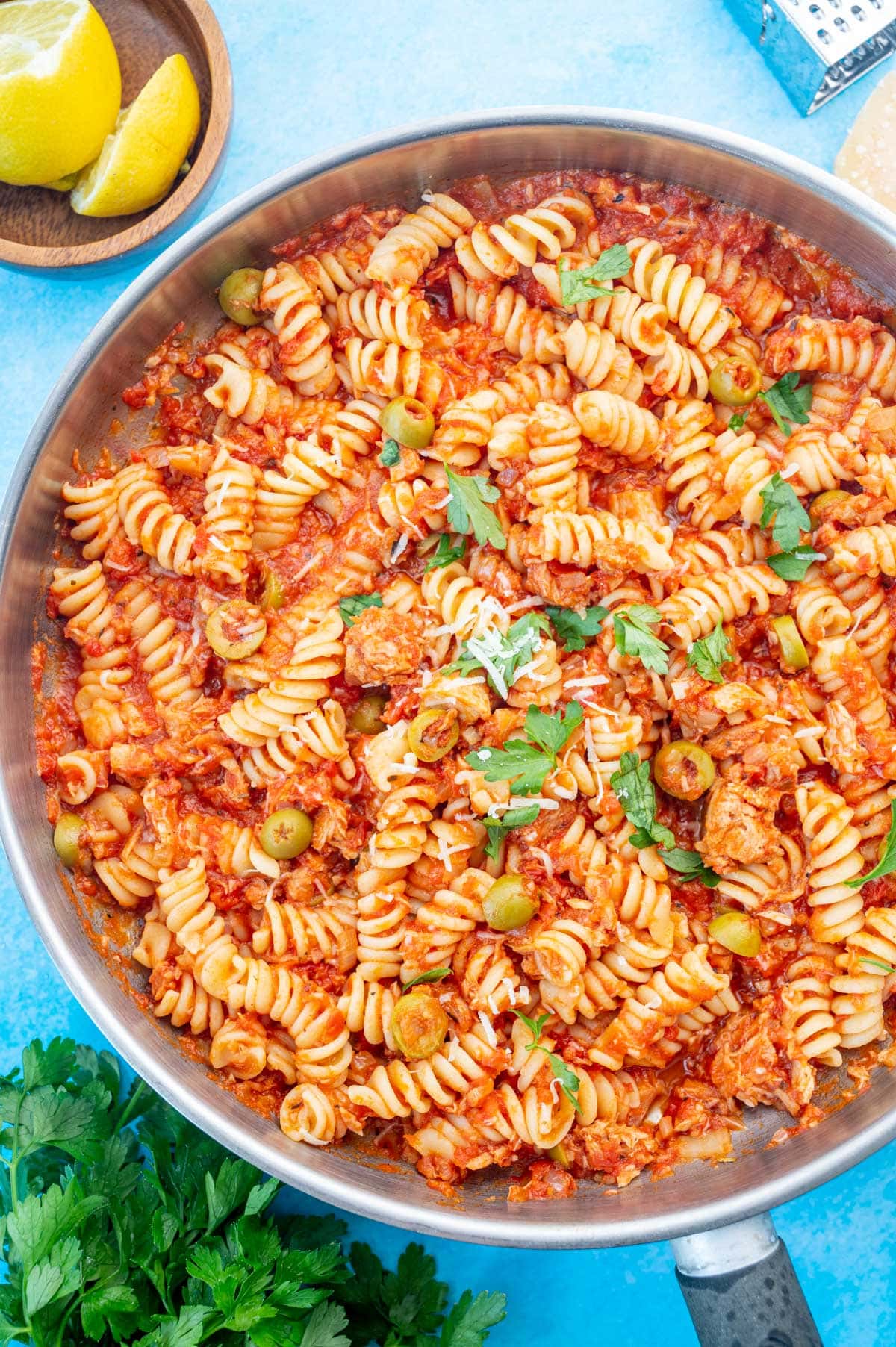
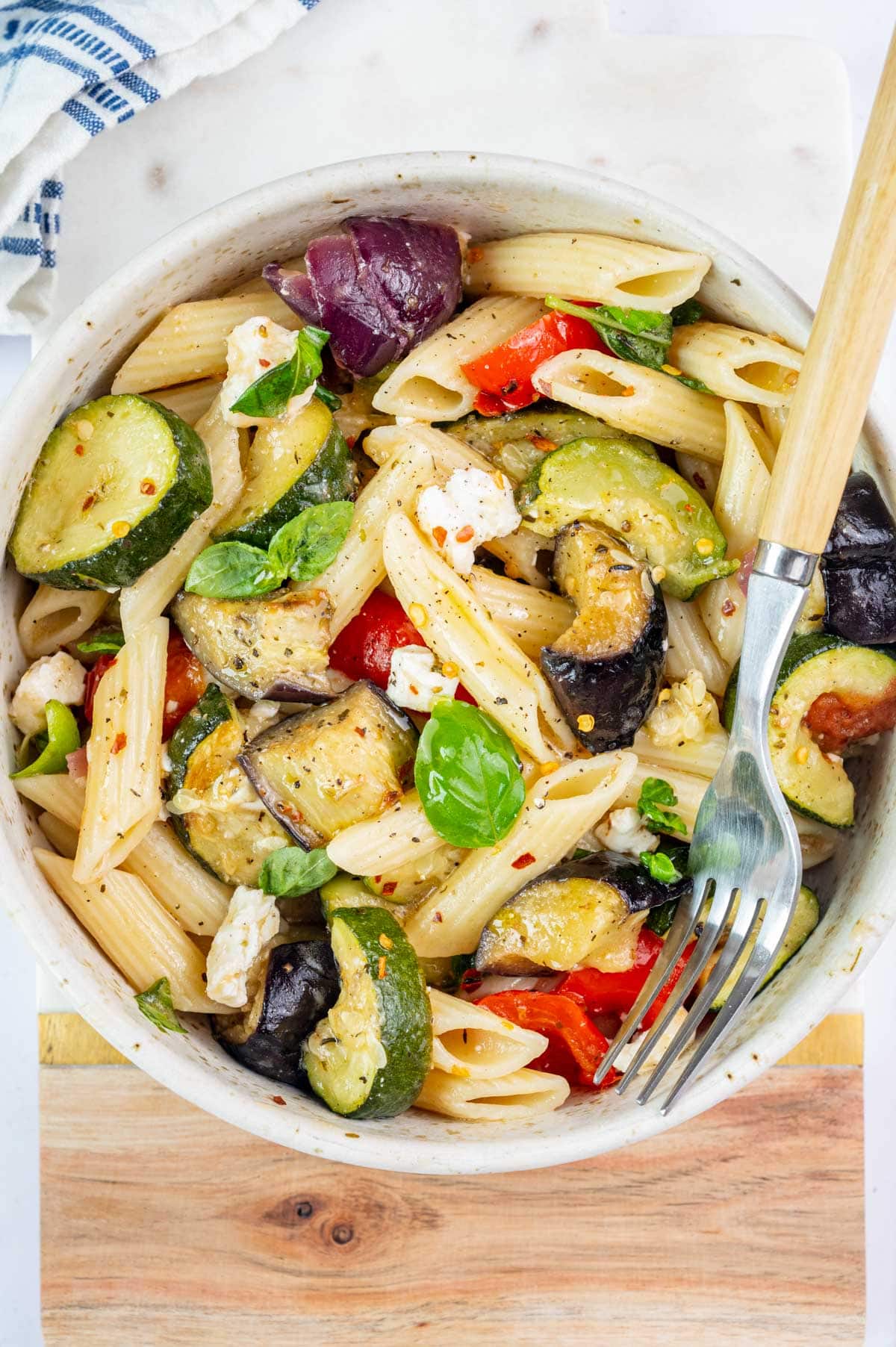
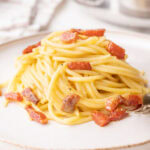
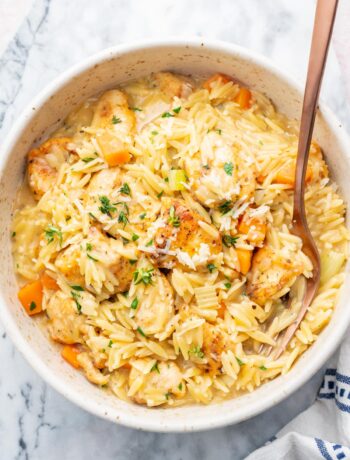

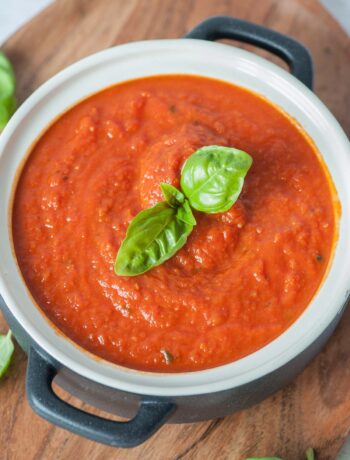
No Comments